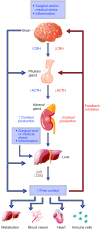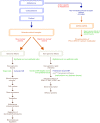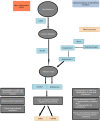CIRMI-a new term for a concept worthy of further exploration: a narrative review
- PMID: 35813323
- PMCID: PMC9263790
- DOI: 10.21037/atm-21-5572
CIRMI-a new term for a concept worthy of further exploration: a narrative review
Abstract
Background and objective: Critical illness-related corticosteroid insufficiency (CIRCI) describes hypothalamic-pituitary-axis impairment during critical illness associated with three major pathophysiological events; dysregulation of the hypothalamic-pituitary-axis, altered cortisol metabolism, and tissue corticosteroid resistance. Similar changes are evident with regard to mineralocorticoid dysfunction in critical illness. Hyperreninemic hypoaldosteronism describes a sub-population of critically ill patients with an impaired adrenal aldosterone response to increased levels of renin. In the light of the recent demonstration of significant mortality improvements associated with adjunctive glucocorticoid treatment in combination with fludrocortisone in septic shock, and the suggestion that angiotensin II is effective in treating vasodilatory shock, the clinical relevance of mineralocorticoid dysfunction in critical illness requires further exploration. This interpretative review considers hyperreninemic hypoaldosteronism, a concept worth re-examining in the light of the potential mortality benefit of mineralocorticoid supplementation in critical illness. We compare the pathophysiological and clinical characteristics of CIRCI and hyperreninemic hypoaldosteronism, two syndromes that represent corticosteroid and mineralocorticoid dysfunction in critical illness. We highlight gaps in the literature and give novel insights into the limitations of assessment, diagnosis and treatment.
Methods: English language abstracts and articles published before June 2021 were identified through PubMed and Google Scholar. Randomized trials, observational studies, basic sciences studies, systematic and narrative reviews were considered. Reference lists of articles were searched for further relevant material.
Key content and findings: Difficulties are encountered in interpreting measures of gluco- and mineralo-corticoid activity in critical illness. Aldosterone levels, like cortisol, have been shown to be increased in sepsis and hemorrhagic shock. The finding of hyperreninemia and hyperaldosteronism with an aldosterone/plasma renin activity ratio below 2 should prompt consideration of hyperreninemic hypoaldosteronism, a finding, which likely signifies the loss of negative feedback control of the renin-angiotensin-aldosterone system.
Conclusions: As there is evidence to suggest that in acute critical illness, hyperreninemic hypoaldosteronism, is associated with poor outcomes, co-administration of hydrocortisone with fludrocortisone in patients with septic shock should be considered. In keeping with the concept of CIRCI, we suggest the term critical illness-related mineralocorticoid insufficiency as a more appropriate description of the impaired aldosterone response to increased levels of renin seen in this group of patients.
Keywords: Adrenal insufficiency; corticosteroid insufficiency; critical illness; glucocorticoids; mineralocorticoids.
2022 Annals of Translational Medicine. All rights reserved.
Conflict of interest statement
Conflicts of Interest: All authors have completed the ICMJE uniform disclosure form (available at https://atm.amegroups.com/article/view/10.21037/atm-21-5572/coif). The authors have no conflicts of interest to declare.
Figures




References
-
- Annane D, Pastores SM, Arlt W, et al. Critical illness-related corticosteroid insufficiency (CIRCI): a narrative review from a Multispecialty Task Force of the Society of Critical Care Medicine (SCCM) and the European Society of Intensive Care Medicine (ESICM). Intensive Care Med 2017;43:1781-92. 10.1007/s00134-017-4914-x - DOI - PubMed
-
- Marik PE, Pastores SM, Annane D, et al. Recommendations for the diagnosis and management of corticosteroid insufficiency in critically ill adult patients: consensus statements from an international task force by the American College of Critical Care Medicine. Crit Care Med 2008;36:1937-49. 10.1097/CCM.0b013e31817603ba - DOI - PubMed
-
- Annane D, Pastores SM, Rochwerg B, et al. Guidelines for the Diagnosis and Management of Critical Illness-Related Corticosteroid Insufficiency (CIRCI) in Critically Ill Patients (Part I): Society of Critical Care Medicine (SCCM) and European Society of Intensive Care Medicine (ESICM) 2017. Crit Care Med 2017;45:2078-88. 10.1097/CCM.0000000000002737 - DOI - PubMed
Publication types
LinkOut - more resources
Full Text Sources
Research Materials
